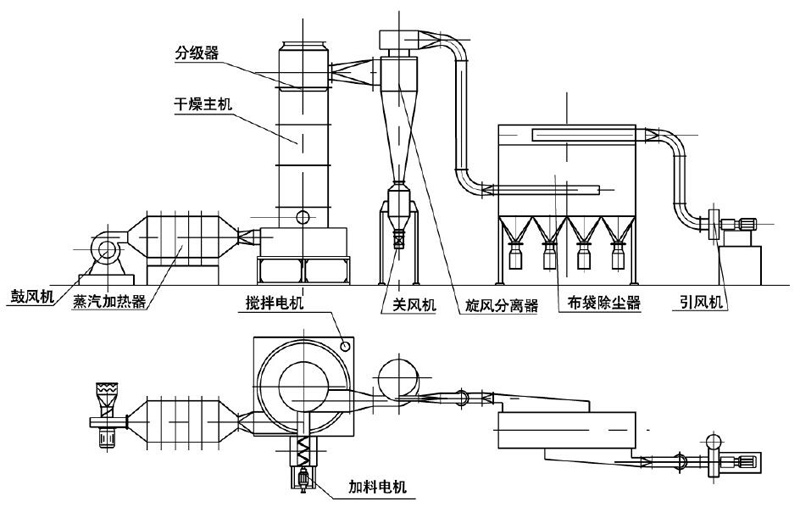Hotline
+8615161118388

Working principle
The hot air tangent enters the bottom of the dryer and forms a strong rotating wind field driven by the agitator. The paste material enters the dryer through the screw feeder. Under the strong action of the high-speed rotating agitator, the material is dispersed under the impact, friction and shear force. The block material is quickly crushed, fully contacted with the hot air, heated and dried. The dehydrated dry material rises with the hot air flow, the grading ring intercepts the large particles, and the small particles are discharged from the center of the ring outside the dryer, and recycled by the cyclone separator and dust collector. The dry or large materials are thrown to the wall by centrifugal force, and then fall back to the bottom for crushing and drying.
Performance characteristics
◎ The organic combination of swirl, fluidization, spouting and crushing classification technology.
◎ Compact equipment, small size, high production efficiency, continuous production, realizing "small equipment, large production".
◎ High drying intensity, low energy consumption and high thermal efficiency.
◎ The material has a short retention time and good quality, which can be used for drying heat-sensitive materials.
◎ Negative pressure or micro negative pressure operation, good airtightness, high efficiency, and elimination of environmental pollution.
Applicable materials
Organic substances: atrazine (pesticide insecticide), lauric acid, benzoic acid, benzoic acid, fungicide, sodium oxalate, cellulose acetate, organic pigments, etc.
Dyes: anthraquinone, black iron oxide, indigo pigment, butyric acid, titanium hydroxide, zinc sulfide, various azo dye intermediates.
Inorganic substances: borax, calcium carbonate, hydroxide, copper sulfate, iron oxide, barium carbonate, antimony trioxide, various metal hydroxides, various heavy metal salts, synthetic cryolite, etc.
Food: soybean protein, gelatinous starch, wine tank, wheat sugar, wheat starch, etc.
Structure diagram

Parameter/Model | Barrel diameter(mm) | Host size(mm) | Host power(kw) | Processing air volume(m³/h) | Evaporated water volume(kg/h) |
XSG-200 | 200 | 250x3000 | 5~9 | 300~800 | 10~20 |
XSG-300 | 300 | 400x4500 | 8~15 | 600~1500 | 20~50 |
XSG-400 | 400 | 50x5000 | 10~17.5 | 1250~2500 | 25~70 |
XSG-500 | 500 | 600x5500 | 2~24 | 1500~4000 | 30~100 |
XSG-600 | 600 | 700x5500 | 20~29 | 2000~5000 | 40~200 |
XSG-800 | 800 | 900x6500 | 24~35 | 3000~8000 | 60~600 |
XSG-1000 | 1000 | 1100x6800 | 40~62 | 5000~12500 | 100~1000 |
XSG-1200 | 1200 | 1300x7000 | 50~89 | 10000~20000 | 150~1300 |
XSG-1400 | 1400 | 1500x7000 | 60~105 | 14000~27000 | 200~1600 |
XSG-1600 | 1600 | 1700x7500 | 70~135 | 18700~36000 | 250~2000 |
XSG-1800 | 1800 | 2000x8000 | 100~180 | 30000~40000 | 300~2500 |
XSG-2000 | 2000 | 2200x9000 | 150~200 | 35000~45000 | 400~3000 |
